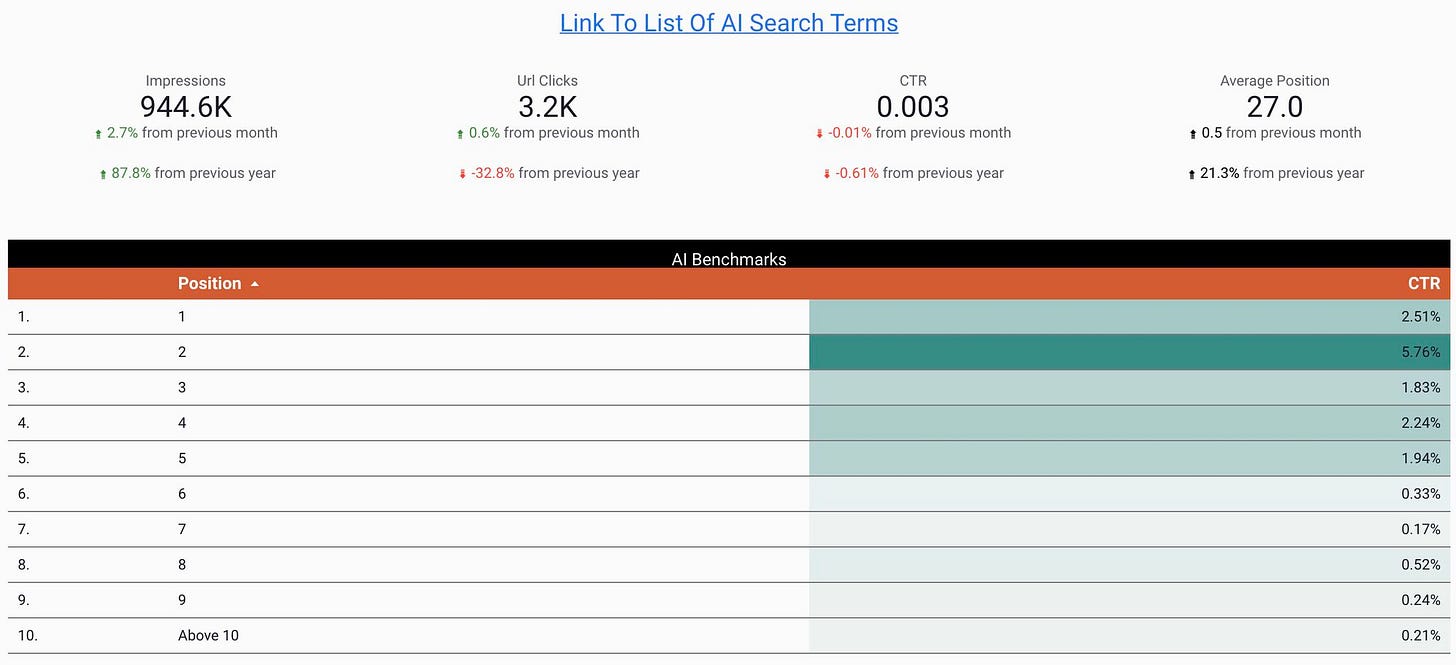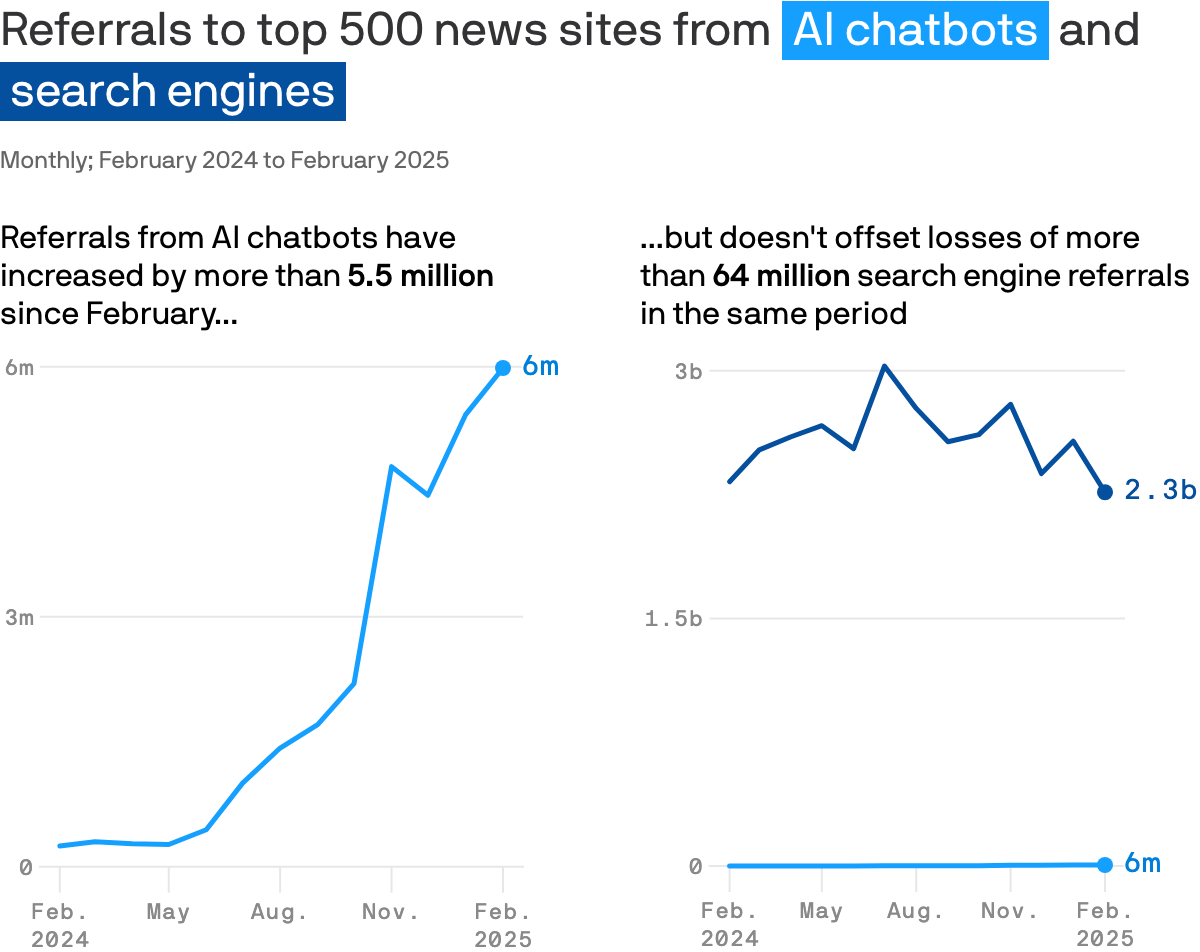Welcome to Edition No. 103 of my weekly newsletter, providing practical analysis in the world of digital content strategy.
I’m starting a garden for the first time. (Hence the “compost” search example below – it was on the brain.)
Getting started was easy. Last year, I saved seeds from fruits and vegetables we liked (and that could grow in Middle Tennessee).
In February, I started peppers and tomatoes in cells with coconut coir (which I hadn’t heard of previously) and grow lights.
The seedlings sprouted and the first leaves appeared.
I was off to a roaring start.
But I had nowhere to plant these, well, plants once the first frost date passed.
I knew I wanted raised beds – and exactly where I would put them – but I had to build them first. And to build them, I had to buy the materials.
Do you have any idea how expensive untreated Canadian cedar is?!
If I told you how much I paid for 16 2” x 6” x 8’ boards, you would probably think I imported 100 liters of organic maple syrup instead.
Once I had the lumber, I ran into another “problem” I hadn’t pre-calculated: I needed soil to fill those 160 cubic feet of raised beds. (I built four of them measuring 8’ x 5’ x 1’.)
Which meant buying two pallets – 120 bags – of organic soil from Home Depot. And wouldn’t you know, even though it’s five minutes from my house, they won’t deliver.
And since I don’t have a truck, my friend Joe is going to accompany me tonight to transport them, hopefully in no more than two trips.
I’ll share the literal fruits (and vegetables) of my labor later this spring.
In the meantime, 100 percent of paid subscriptions acquired this week will be used to support this investment in my family’s healthy eating habits. (And those cute headbands my wife found for our infant daughter.)
In this edition:
Why Your Organic Search Traffic is Down
How To Know if You’re in Trouble
What To Do About it
Two LLM Tracking Templates
Why Your Organic Search Traffic is Down
Google completed its latest core update, which lasted two weeks1, Thursday.
It was the first core update of 2025.
“This is a regular update designed to better surface relevant, satisfying content for searchers from all types of sites. We also continue our work to surface more content from creators through a series of improvements throughout this year. Some have already happened; additional ones will come later.”
As a refresher, here’s why it’s so important to rank well on Google:
Historically, you could count on clickthrough rates around 40 percent if you held the No. 1 position for an organic search query.
Even ranking No. 9 meant getting 2 percent of clicks.
So, for a keyword with a monthly search volume of 100, you could expect between 1-40 Google / Organic referrals per month, depending on your ranking.
Now, however, you would be lucky to get a quarter of the traffic you had before.
At least based on what I’m seeing in anecdotal LinkedIn posts, including this one from Mark Barrera.
The culprit?
There are two frontrunners.
‘Low-Quality’ Content
I put “low-quality” in scare quotes because this is subject to Google’s “opinion.”
Here’s a high-level, no-shade explanation of that opinion.
(If you’re familiar with E-E-A-T, and Reddit-related controversies, you can skip ahead.)
Google says its goal is to surface the most relevant information possible to organic search users.
To increase your chances of ranking high on its SERPs, you should create “helpful, reliable, people-first content.”
And that’s where the subjective part comes in.
There has been no shortage of controversies on this topic in the last year or so.
Small, independent websites that get ripped off – and subsequently outranked – by behemoth publications that copy their content
The curtain being pulled back on the wizard in the form of a massive internal documents leak
A partnership with Reddit that oh-so-coincidentally resulted in a surge of organic search traffic to the social network
I bring these up to show that 1) Google’s view of what makes “quality” content is often far different than many publishers’ and 2) behind that scenes, Google does things that benefit its business (naturally) in a way that seems to catch people more offguard than a tornado in Maryland2.
With all that taken into account, the first reason many sites have seen massive traffic dropoffs is because their content is no longer considered “quality” by Google’s definition.
AI Overviews
Those AI-generated summaries at the top of Google search results are more prominent than ever.
This means more zero-click searches, where the user likely got the information they needed directly on the page, negating the need to click through to any site.
Barrera’s data, though – linked above – suggests something else is also afoot.
Having your content cited in AI overviews is great for boosting impressions, but terrible for clickthrough rate.
His data – based on clients’ traffic, I imagine – found that the No. 2 position gets more clicks than the No. 1* position.
(*He’s counting the first position after AIO as No. 2. Since that’s the first “traditional” listing on the SERP, I would count that as No. 1. It’s sort of splitting hairs, but an important distinction nonetheless.)
So, not only are AI overviews bringing down the overall clickthrough rate, but you’re actually better off showing up in traditional SERP slots and not AI overviews, even though users see them first.
A new report from Similarweb – found in yesterday’s Axios Media newsletter – sheds more light on this.
Yes, Google traffic still crushes LLM referrals, but Google’s referrals are falling more than 11 times faster than chatbot traffic (which goes beyond Google AIOs) has grown.
It’s like we’re burning through fossil fuels while a few hippies or rich people or both are putting solar panels on their roof.
(I have nothing against hippies nor rich people, though I consider myself to be neither.)
How Do You Know You’re In Trouble?
While I recommend looking at GA4 reports for more comprehensive data on your Google / Organic traffic, a quick and easy way to start is in Google Search Console.
Check Google Traffic in Google Search Console
1. Go to the Performance tab.
2. Set the date range to at least three months, though 12 months is probably best. You’ll notice spikes more easily.
There are four mappable metrics: clicks, impressions, CTR and average position.
The only one I wouldn’t pay much attention to here is average position. Tools like Ahrefs and Semrush will give you better data than GSC.
3. I would start by analyzing impressions. This will tell you how often your content appears in Google search results.
If this has a significant dip over time, it almost certainly means your rankings have dropped. The less-than-one-percent likely alternate explanation is that people are no longer searching for terms that they used to, so your content no longer shows up.
(The latter scenario is more likely for news sites that cover a popular story – probably breaking news – that the public initially searched for in high volume then largely forgets about.)
But 99.9 percent of the time, it’s because you’re not ranking as well.
Your rankings may have dropped because:
Competitors posted newer and/or better content
Google updated its algorithm and your site was not looked upon favorably
You made changes to your content, which was updated in Google’s index, negatively affecting its ranking
(When done well, this usually has a positive effect)
4. Next, I would look for a drop in clicks. If your impressions go down and your clickthrough stays the same, your clicks will decrease, too. #Math
But if your impressions are consistent while your clicks drop, it’s more complicated.
This could be for a couple of reasons:
Your content no longer matches the search query intent, so users are less likely to click through
There’s been a change to the content, and how it’s presented, on the SERP, which decreases a user’s likelihood of clicking content
💡 When a user searches but doesn’t click a link on the SERP, it’s called a zero-click search
This brings us back to the AI overviews issue we discussed in the introduction.
The Problem with AI Overviews
We’ll leave aside the fact that, months ago, Google’s AI-generated results were telling people to put glue on their pizza.
To illustrate the issue we are going to discuss, here’s a SERP for a “how to compost” search.
According to Barrera’s data, referenced further above, users are more likely to click the US EPA link than they are the Better Homes & Gardens link cited for the AI overview.
This is counterintuitive because, traditionally, the higher – physically, on the screen – you ranked on the SERP, the better. But now, the AI Overview is providing such dense information – and more accurate than glue-pizza days – that even clicking through for a more complicated topic like composting is no longer necessary.
Just look at what happens when I click the show more button to expand the AIO results:
It continued for seven detailed steps!
As someone who has been composting for more than a year, I can attest that there’s more than enough info in these steps to get started.
If my goal is to get the minimum amount of information I need to get started, I have little incentive to click any of the three links on the right widget.
And for whatever reason, people who do want more information are more likely to click that US EPA link in the No. 1 traditional slot than they are the AIO citations.
And even then, users are far less likely to click that traditional No. 1 slot than they were even a year ago.
So now what?
No Silver Bullet
Scenario: Your search impressions may or may not be down, but your organic traffic from Google has been on a slow decline for the past year. (If not, congratulations!)
This is despite the fact that your rankings are improving and you continue to produce non-AI-garbage content.
The logical question to ask, then, is: What can I do about it?
It’s a ‘Branding Exercise’
Try selling this one to your executive team:
“While we may get fewer clicks from Google search, our impressions are strong, which means we’re building brand awareness.”
The response will probably be something like: “How can I sell brand awareness?! I need ad impressions! Warm leads! Free trials! Demo requests!”
And while they will have a point, it doesn’t mean that brand awareness is worthless, even if more difficult to quantify.
I suppose the point of this “option,” then, is twofold.
1. Selling “brand awareness” alone as a KPI/OKR probably won’t go over well with most C-suite leaders…
2. …but that doesn’t mean you shouldn’t still strive to rank high on Google and show up in AI overviews.
Embrace the LLM Beast
ChatGPT, Claude, Perplexity, Gemini, Grok, DeepSeek…pick your LLM.
They’re not going anywhere. Which is to say, they’re the future of online query sources. (And so much more.) Just refer to the Axios chart above.
So, if you aren’t already thinking about how to not only get more traffic from LLMs, but stake as significant of a portion of your content strategy on them as you have been for organic search, you’re already behind. (Sorry.)
Here are two ways, at the most fundamental level, you can get started:
Set Up LLM Visibility Tracking
There are multiple software available that will do this for you. I haven’t yet found one that I love, so I still track these in a spreadsheet.
Here’s how I set it up:
Column A: Content clusters/topics.
Column B: Questions you think users are likely to ask the LLMs where you want to show up in the results.
Columns C and beyond: Have one row per brand per LLM model. I’ll explain.
Let’s say you want to track yourself and four competitors. That’s five brands.
Now let’s say you want to track results from three LLMs: ChatGPT, Perplexity and Gemini.
Each column from C-G would be dedicated to your brand and the four competitors. And columns C-G as a group would be dedicated to ChatGPT.
Repeat for columns H-L and M-Q for the other two LLMs.
Then, columns C-Q as a whole would be dedicated to one date – I choose the first weekday of each month – of tracking.
Since you’ll be manually inputting the data, I would be selective about the questions so you don’t have to search too many.
I’m sure 1) there will soon be an affordable software solution for this and/or 2) you could whip up some automation yourself.
In the meantime, this spreadsheet is my friend.
If you would like a template, reply to this email or message me on LinkedIn.
Track LLM Traffic, Events in GA4/Looker Studio
This is to track the traffic LLMs drive to your site and the events that occur when they do.
The setup here isn’t as straightforward as the spreadsheet, so I won’t walk you through the steps because your eyes would bleed, but hit me up on email or LinkedIn for this template, too.
Here are your takeaways:
I didn’t mention this yet, but Google / Organic traffic is NOT dead! It’s not going away. Don’t believe the alarmists. It’s still an important channel.
But it’s evolving, too. And it will continue to drive less and less traffic over time.
So your Google / Organic strategy needs to evolve.
And you need an LLM strategy, too.
These and other content strategies must be crafted through the lens of “How will they reach my target audience, which will, in turn, help my business grow?”
What are you doing to adjust to the new world order of search referrals? Let me know in the comments.
Google Analytics 4 Course for Content Creators
Sign up here for lifetime access to my advanced GA4 course:
Paid subscribers of this newsletter have a discount code waiting for them. All you have to do is email me and I’ll send it over.
This newsletter is self-edited, so please don’t be shy about emailing me if you spot a mistake.
Disclaimer: I own stock in some of the companies I write about. I do my best to remain unbiased when doing so.
13 days and 21 hours, to be precise
My home state. Now, in Nashville, no one is caught off-guard by a twister.











